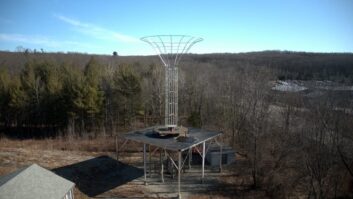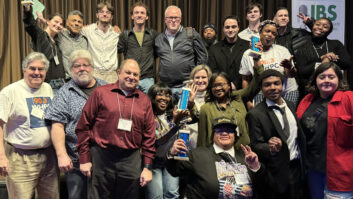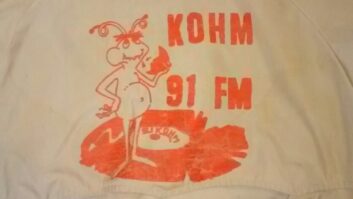During broadcast radio’s first decade, little thought was given to transmitter efficiency. Main concerns of the industry were availability of broadcast spectrum (sound familiar?); keeping transmitter power supply hum to a minimum; and antenna systems (which were then something of a “black art”). In the 1920s, electricity was relatively cheap, and as the country (and the world) had been smitten by this new thing called broadcasting, what mattered most was just getting a signal on the air. The public craved radio, and early on just about anyone who had a station and wanted to sell airtime could rack up some nice profits. Electric bills were secondary.

Fig. 1: William H. Doherty As examples of state-of-the-art efficiency (or perhaps inefficiency) from this period, RCA marketed a 1 kW rig, the 1B, which drew a mere 13,000 Watts from the AC mains. This translates to an efficiency of slightly better than 7.5 percent. Western Electric’s 7A transmitter — one of the first commercially available 50 kW transmitters — consumed some 230,000 Watts of AC power, netting a 21 percent efficiency level). Common to both transmitters was low-level modulation and linear amplification of the radio frequency signal.
THE “GREEN MOVEMENT” IN RADIO TRANSMITTERS BEGINS
As the country entered the Great Depression, and more and more broadcasters were clamoring for higher-power stations and consumption of electricity began to be taken more seriously, some far-sighted individuals realized that if you build a more efficient transmitter, station owners will love you.
First out of the gate was Loy Barton with his high-level plate modulation scheme that operated in Class B mode and ran circles around Raymond Heising’s “constant current” design that required a watt of Class A audio for every watt of RF delivered. Barton’s system was adopted for the 500,000 Watt machine installed at WLW in 1933 and provided a great savings in power consumption over other available transmitter architectures of the period. It was good, really good by comparison; consider the 500,000 Watts of Class A audio that would have had to be generated for a similar-sized Heising rig. But other engineers were beginning to visualize still more efficient ways of achieving amplitude modulation for the increasingly higher-powered transmitters being demanded by broadcasters; rigs that didn’t require power companies to install additional generating capacity or keep transformer companies working overtime to turn out gargantuan steel and copper assemblies needed by the Barton design.
Willian H. “Bill” Doherty was a Harvard engineering school graduate with an employment history that included both AT&T Long Lines and the National Bureau of Standards before he joined Bell Laboratories in mid-1929. To better understand the place of Bell Labs in the scheme of things, it should be noted that the laboratory was half-owned by AT&T; the other held by the supplier of equipment for Bell System operating companies, Western Electric. Western Electric (W.E.) was a major player in the broadcast equipment market then, and Doherty soon became involved with high-power transmitters used in both radio broadcasting and transatlantic telephony.
It’s uncertain exactly when and why Doherty became concerned about raising transmitter efficiency. However, it may have had something to do with keeping his employer competitive in light of the developments by Barton down in Camden, N.J., and one Henri Chireix over in France. Doherty cites the inventions — Class B plate modulation and “out-phasing” — of both gentlemen in the first page of his paper describing his own invention (see reference [1] at end of the story). Or it could have had something to do with the almost concurrent development at Bell Labs of the massive 320A 250 kW triode, a device that seemed ideally suited for a really high-power implementation of his amplifier circuit.
Regardless, Doherty’s new linear amplifier concept aroused a lot of interest in the broadcast engineering community, as he claimed that it nearly doubled the efficiency of RF linear amplification (60 to 65 percent vs. 33 percent for conventional designs). The formal announcement of the revolutionary technology took place in May 1936 at the Institute of Radio Engineers annual convention, and the unveiling of an actual Doherty working model occurred the following year at the NAB Show in Chicago. [2]
Even the amateur radio community took note, with QST magazine publishing an article on constructing a ham rig using Doherty’s new method of RF amplification. [3]
Doherty’s circuit allowed Western Electric’s transmitter line to remain competitive with RCA and its Barton modulation. Western Electric still followed its early transmitter architecture, with modulation of the RF carrier taking place early in the chain and then being boosted by linear amplifier, but now with much higher efficiency. In addition to trimming electric bills, the Doherty invention negated the requirement for large specially-designed modulation transformers needed in the Barton configuration, thus saving a lot of transmitter building floor space and giving W.E. marketing people something else to crow about.
HOW DID HE DO IT?
Doherty’s revolutionary circuit may be a bit difficult to wrap one’s brain around at first glance. After all, it only took about 30 years to get from Reginald Fessenden’s carbon microphone amplitude modulation methodology to Doherty’s design.

Fig. 2: A simplified version of the Doherty “high-efficiency” amplifier circuit. However, a good starting point is to think of it as a parallel arrangement of two triodes, with the first biased for Class B operation (the “carrier” tube) and the second biased for Class C (the “peak” tube). See Fig. 2. The “carrier” tube is working 100 percent of the time, handling “average” signal levels. Whenever the peak-to-peak amplitude of audio delivered by the modulator exceeds what the carrier tube can handle, the larger signal causes the “peak” tube to begin conducting to handle the “excess.”
However, you don’t get Doherty operation by just summing the output of two differently biased amplifiers. It takes considerably more finesse. The key to understanding the circuit is the operation of a 1/4-wavelength transmission line. If you remember your radio theory, you’ll recall that an interesting consequence of nature occurs when you have a transmission line that’s precisely one-quarter of a wavelength at the frequency of interest. This is impedance inversion. If the 1/4-wavelength “transmission line” (it could be a piece of coax or an equivalent L/C-simulated delay) is terminated with a load having a very low impedance, this appears as a very high impedance at the other end and vice versa. Doherty’s bit of legerdemain relies heavily on this impedance-inverting principle.
Imagine two triodes (or tetrodes, or your favorite solid-state amplifying device) with their outputs (plates in this tube example) connected through a 1/4-wave piece of coax and their grids fed with the same signal to be amplified. The left tube is labeled the “carrier” tube and the right one the “peak” tube. As shown in Fig. 2, there’s also a load on the “far” side of the 1/4-wavelength coax to which we’ll assign the value of R/2. Remember the carrier tube is Class B-biased and the peak tube is operating as a Class C amplifier. Due to the inversion property, the load impedance “seen” by the carrier tube is 2*R as long as the peak tube is cut off.

Fig. 3: These waveforms illustrate the operation of the Doherty configuration. Adapted from the drawing in Doherty’s 1936 Proceedings of the IRE article. When excitation is provided to the grid of the carrier tube, it amplifies in a normal manner, working into a load of 2*R and delivering its amplification fairly efficiently (around 60 percent). However, as the excitation to the carrier tube is increased, it reaches the point where amplification can’t go any higher due to the limitation imposed by the plate voltage potential (it’s hitting the “rails”). At this point, any further increase in excitation results in clipping of the waveform presented to the grid. The circuit is designed so that when the carrier tube reaches this “saturated” operating condition, the Class C (peak) tube begins to conduct, adding its output to the load shared by both tubes and also changing its plate impedance from essentially infinity to a lower value. This impedance change is inversely reflected back to the carrier tube as a lower impedance, causing that tube to deliver additional power without an increase in the plate voltage available (P=E2/R). At 100 percent excitation, the carrier tube is now delivering two times the carrier power. The peak tube is also “maxed out,” working as hard as it can, delivering two times the carrier power. Thus on 100 percent modulation peaks, the tubes in tandem are supplying four times the normal (unmodulated) carrier. As seen in Fig. 3, the output of the carrier tube is horribly distorted (peaks clipped), but the Class C peak tube is operating linearly at this point and when the output of the two are summed, the result is a fairly complete representation of the modulated AM signal driving them.
An unavoidable consequence of the 1/4-wavelength plate circuit delay line is that the outputs of the tubes are 90-degree out of phase. This is easily set right by placing another 1/4-wavelength delay line in the grid circuit of the carrier tube as shown.
In concluding his write-up of the new circuit, Doherty noted that its efficiency was such that a 50 kW transmitter constructed with the amplifier would only require about 135 kW of mains power. He estimated that this was “less than the power dissipated by the water-cooling system [alone] in the usual 50 kilowatt installation.”

Fig. 4: This Western Electric 407A 50 kW Doherty transmitter was installed at Washington, D.C.’s WJSV (later WTOP) in 1940. The Granville Klink collection Doherty’s circuit was quite revolutionary, and while the W.E. transmitters constructed with it (the company offered Doherty products at one, five and 50 kW power levels) began to appear on the market were not exactly “runaway” successes — recall the relative long amortization period associated with transmitter purchases. Western Electric did sell a fair amount of “Doherty” transmitters before government intervention ended the company’s involvement in broadcast product manufacturing in the 1950s. The first of the new breed of “greener” 50 kW rigs was installed at Louisville’s WHAS. Another early Doherty adopter was Washington, D.C.’s WJSV (later rechristened WTOP). See Fig. 4.
GOING FOR SOME SERIOUS DOHERTY WATTS
The biggest implementation of Doherty’s new circuit, however, did not take place in the United States, but just over the border from Del Rio, Texas, in Villa Acuña (now Ciudad Acuña), Mexico.
John R. Brinkley, the quack doctor who hawked his services over nighttime airwaves, wanted a louder voice for his “on-the-border” station, XERA, and enlisted consulting engineer James O. Weldon to boost the station’s output at least the 500,000 Watt level being emitted then by Cincinnati’s WLW. Weldon decided to take advantage of Doherty’s cutting-edge design and soon mapped out a plan for taking “Doctor” from a paltry 150,000 kilowatts to the half-megawatt level. It also helped that W.E. was now delivering the 320A 250 kW tube previously mentioned, as Weldon’s design called for eight of the 320As (two paralleled carrier tubes and two paralleled peak tubes) in each of the two combined 250 kW amplifiers used in his 500,000 Watt machine, which Brinkley used to better spread the word about his impotency cure to the men of North America.
As Weldon described the project: “It represent[ed] the first application of the Doherty high-efficiency circuit in a transmitter of greater than 100,000 Watts, and the first commercial use of a recently developed 250,000 Watt transmitting vacuum tube.”[4]
As with a lot of radio engineering projects, Weldon was under the gun on a number of fronts including budget (he re-used as many of the components from the existing transmitter as possible), time (he was given eight months to complete the project) and space (as much of the new transmitter apparatus was fitted into the XERA building as possible, but a wall did have to be blown out and an additional room created). Last, there could be no interruption to the station’s normal operating schedule. I’m sure that all of these constraints will sound familiar to readers.
Nevertheless, the superpower boosting project appears to have been a complete success, with Weldon reporting virtually flat (within ±1 dB) audio frequency response between 30 Hz and 12 kHz and an overall efficiency of 37 percent. More about XERA project and Weldon’s unpublished paper is available in a 1996 article by Durell M. Roth. [5]
It’s reported that both Bill Doherty and the developer of the W.E.320A tube, H. Eugene Mendenhall, visited the XERA project site [6], and it’s speculated that there was some amount of communication between Weldon and Doherty during and after the project, leading to a rather interesting licensing arrangement over the use of the circuit which will be examined shortly.
OTHER DOHERTY IMPLEMENTATIONS
The emergence of World War II slowed Western Electric’s transmitter business, but not before competitor RCA got into the act with its own version, the 50D, which premiered in 1937. It was at heart a Doherty transmitter, but was constructed with 90- and 270-degree phase shifting to skirt W.E. patents. Only a few of the 50Ds were sold, apparently due to challenges from Western Electric, with the RCA reverting back to Barton modulation for their next (50E) 50 kW machine. The Marconi Company also produced a Doherty-based transmitter, the B6034, but this was much later in the scheme of things.
Once World War II ended, Western Electric, along with many other companies that had devoted much of their production capacity to the war effort, returned to peacetime production, and more Doherty-architecture transmitters were placed into service by broadcasters wanting more efficient rigs to replace aging earlier models. However, there was a slight rub, as the U.S. government had targeted the Bell System’s monopolistic business practices and begun a long-running legal action that ultimately “broke up” Bell and its various operating arms. Included in these was the Bell System’s equipment supplier, Western Electric.
A 1956 consent decree that came about as a result of the antitrust action put W.E. totally out of the business of supplying broadcast-related products.
However, this did not stop the production of Doherty-architecture transmitters. Shortly after the war ended, Weldon, along with a couple of other radio engineers, had established a broadcast equipment manufacturing firm — Continental Electronics — and this company picked up where W.E. left off. (Actually, Continental was manufacturing Doherty rigs for some years prior to the consent decree, with ads in early ’50s trade magazines, depicting Continental transmitters that bore a strong physical resemblance to Western Electric models, and touting high efficiency.) Ron Rackley notes that the Graybar Electric Co., Western Electric’s electrical component distribution arm, was also marketing Continental transmitters in the early ’50s. [7]

Fig. 5: The schematic drawing accompanying James Weldon’s U.S. patent describing his modification/enhancement to the original Doherty circuit. This author, in a 2008 conversation with a then-retired long-time Continental employee, Whit Griffith, was told that due to Weldon’s close association with Doherty, the company was able to produce Doherty-circuit transmitters on a royalty-free basis, with the proviso that the large components used in their manufacture were purchased from Graybar. It has to be assumed though, that when Continental took over the manufacture of Doherty transmitters from W.E., that all applicable patents would have been acquired by Continental Electronics. Another former Continental employee, Fred Riley, noted that Weldon reworked the original Doherty circuit’s “grounded-cathode” configuration to a “grounded-grid” configuration and this enhancement would have been sufficient to side-step the original Doherty patent. (See Fig. 5.)
“Once J.O. [Weldon] put the carrier tube in grounded-grid, he was home free,” said Riley.
Weldon’s grounded-grid patent was issued in 1958 [8]. He stated in the application that his circuit eliminated the need for neutralization of the carrier triode amplifier tube and provided an improvement at higher frequencies, as it reduced plate-to-ground capacitance.
Another enhancement to the basic Doherty configuration was a move to screen grid (tetrode) amplifying devices by another Continental employee, Joseph Sainton. This development (“screen grid impedance modulation”) provided a number of advantages, including even greater efficiency, as the driver stage had to deliver substantially less power than necessary for feeding triode amplifiers. Sainton’s design [9] was first incorporated in Continental transmitters in the mid-1960s.
THE DECLINE AND REBIRTH OF THE DOHERTY AMPLIFIER
By the 1970s, a number of new amplitude modulation technologies began to emerge, driven in part by the move to digital technology that the entire industry was beginning to embrace then. These new modulation schemes allowed AM broadcast transmitters to provide even greater operating efficiencies than achievable with Doherty technology; however, the demand for Continental’s popular Doherty-based machines continued well into the 1990s.
REFERENCES
[1] Doherty, W. H.: “A New High-Efficiency Power Amplifier for Modulated Waves,” Proceedings of the Institute of Radio Engineers, Sept., 1936, pp. 1,163–1,182.
[2] “The Doherty Amplifier: A Development of Bell Telephone Laboratories,” pamphlet published by Western Electric; undated; however, as several references to 1937 events are included publication would have been in 1937 or later.
[3] Montgomery, Bruce E.: “The Doherty High-Efficiency Amplifier Applied to Amateur ’Phone,” OST magazine, Feb. 1937, p. 30.
[4] Weldon, James O., “A 500,000 Watt High-Efficiency Broadcast Transmitter,” (an unpublished and undated paper likely authored by Weldon in late1939 or early 1940, as he remarks in the paper’s “Conclusion” section that on Sept., 15, 1939 the transmitter had been on the air for one year).
[5] Roth, Durell M., “From the Birth to the Demise of Super-Power Station XERA,” Proceedings of the Radio Club of America, 1996.
[6] Mishkind, Barry, “The Broadcast Archive,” www.oldradio.com/archives/hardware/WE320A.htm
[7] Aug. 28, 2015 correspondence from R. Rackley to the author.
[8] U.S. patent # 2,836,665, “Amplifiers,” applied for Aug. 29, 1957 and issued May 27, 1958.
[9] U.S. patent # 3,314,024, “High-Efficiency Amplifier and Push-Pull Modulator,” applied for March 25, 1964 and issued April 11, 1967.
According to Richard Garret, who works in Continental’s field service operation, the last of the Doherty linage rolled off the production line in 1993.
“It was a 316F1, a 10 kW model,” said Garret. “It went to a station in Honduras. The last 317, a 317C3 was completed in 1990 and went to [station] XEG in Mexico.”
However, it seems that all things have to come to an end and as the decade of the ’90s wrapped up, the Doherty circuit had pretty much disappeared from the transmitter landscape.
Or had it?
Enter the era of the cellular telephone and introduction of digital broadcasting in the new millennium. As both services continued to expand, design engineers sought higher and higher transmitter efficiencies, and their search led back to the Doherty amplifier. It’s now incorporated in many broadcast transmitter and cellphone products. In the broadcast sector, Hitachi Kokusai Comark, GatesAir, Rohde & Schwarz, Toshiba —among others — are producing or are planning to produce Doherty-based designs.
When asked about the reemergence of Doherty technology, Joe Turbolski, Hitachi Kokusai Comark’s director of sales operations, was quick to answer, “It’s all about efficiency.”
Turbolski noted that efficiencies in the mid-30 to mid-40 percent range are now achievable in some of the higher power solid-state designs, and tubeless transmitters are becoming more and more desirable due to the diminishing transmitter maintenance talent pool. After all, it’s much easier and safer to swap low-voltage solid-state amplifier modules than to change out an inductive output tube and/or work on its associated 35 kV power supply.
“Doherty is definitely the wave of the future,” said Turbolski. “We’re getting requests now for 50 kW solid-state transmitters.”
This year marks the 80th anniversary of the introduction the Doherty high-efficiency amplifier. I’m sure that Bill would be proud and happy to know that his invention is still doing well after having achieved octogenarian status. Happy Birthday, Doherty Amp; may you continue to prosper!
James O’Neal is a frequent contributor to Radio World who often writes about the history of broadcast technology. He acknowledges the contributions of Richard Garret, Cole Grace, Jim Haynes, Pamela O’Neal, Ron Rackley, Fred Riley and Joe Turbolski.







